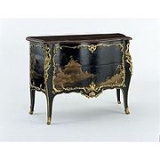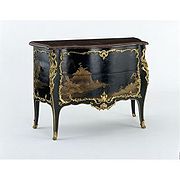
Commode
Encyclopedia

Furniture
Furniture is the mass noun for the movable objects intended to support various human activities such as seating and sleeping in beds, to hold objects at a convenient height for work using horizontal surfaces above the ground, or to store things...
. The word commode comes from the French
French language
French is a Romance language spoken as a first language in France, the Romandy region in Switzerland, Wallonia and Brussels in Belgium, Monaco, the regions of Quebec and Acadia in Canada, and by various communities elsewhere. Second-language speakers of French are distributed throughout many parts...
word for "convenient" or "suitable", which in turn comes from the Latin adjective commodus, with similar meanings.
Originally, in French furniture, a commode introduced about 1700 meant a low cabinet
Cabinet (furniture)
A cabinet is usually a box-shaped piece of furniture with doors or drawers for storing miscellaneous items. Some cabinets stand alone while others are built into a wall or are attached to it like a medicine cabinet. Cabinets are typically made of wood or, now increasingly, of synthetic...
, or chest of drawers
Chest of drawers
A chest of drawers, also called a dresser or a bureau, is a piece of furniture that has multiple parallel, horizontal drawers stacked one above another...
at the height of the dado rail
Dado rail
A dado rail, also known as a chair rail, is a type of moulding fixed horizontally to the wall around the perimeter of a room.The dado rail is traditionally part of the dado and, although the purpose of the dado is mainly aesthetic in modern homes, the dado rail still provides the wall with...
(à hauteur d'appui). A commode, made by an ébéniste
Ébéniste
Ébéniste is the French word for a cabinetmaker, whereas in French menuisier denotes a woodcarver or chairmaker. The English equivalent for "ébéniste," "ebonist," is never commonly used. Originally, an ébéniste was one who worked with ebony, a favoured luxury wood for mid-seventeenth century...
(cabinet-maker) and applied with gilt-bronze mounts
Ormolu
Ormolu is an 18th-century English term for applying finely ground, high-karat gold in a mercury amalgam to an object of bronze. The mercury is driven off in a kiln...
, was a piece of veneer
Wood veneer
In woodworking, veneer refers to thin slices of wood, usually thinner than 3 mm , that are typically glued onto core panels to produce flat panels such as doors, tops and panels for cabinets, parquet floors and parts of furniture. They are also used in marquetry...
ed case furniture much wider than it was high, raised on high or low legs and with (commode à vantaux) or without enclosing drawers. The piece of furniture would be provided with a marble slab top selected to match the marble of the chimneypiece. A commode occupied a prominent position in the room for which it was intended: it stood against the pier
Pier (architecture)
In architecture, a pier is an upright support for a superstructure, such as an arch or bridge. Sections of wall between openings function as piers. The simplest cross section of the pier is square, or rectangular, although other shapes are also common, such as the richly articulated piers of Donato...
between the windows, in which case it would often be surmounted by a mirror glass, or a pair of identical commodes would flank the chimneypiece or occupy the center of each end wall. Bombé commodes, with surfaces shaped in three dimensions were a feature of the rococo
Rococo
Rococo , also referred to as "Late Baroque", is an 18th-century style which developed as Baroque artists gave up their symmetry and became increasingly ornate, florid, and playful...
style called "Louis Quinze
Louis XV of France
Louis XV was a Bourbon monarch who ruled as King of France and of Navarre from 1 September 1715 until his death. He succeeded his great-grandfather at the age of five, his first cousin Philippe II, Duke of Orléans, served as Regent of the kingdom until Louis's majority in 1723...
". Rectilinear neoclassical, or "Louis Seize
Louis XVI of France
Louis XVI was a Bourbon monarch who ruled as King of France and Navarre until 1791, and then as King of the French from 1791 to 1792, before being executed in 1793....
" commodes might have such deep drawers or doors that the feet were en toupie— in the tapering turned shape of a child's spinning top
Top
A top is a toy that can be spun on an axis, balancing on a point. This motion is produced in the most simple forms of top by twirling the stem using the fingers. More sophisticated tops are spun by by holding the axis firmly while pulling a string or twisting a stick or pushing an auger as shown...
. Both rococo and neoclasical commodes might have cabinets flanking the main section, in which case such a piece was a commode à encoignures; pairs of encoignures or corner-cabinets might also be designed to complement a commode and stand in the flanking corners of a room. If a commode had open shelves flanking the main section it was a commode à l'anglaise
Before the mid-eighteenth century the commode had become such a necessary commodity that it might be made in menuiserie
Ébéniste
Ébéniste is the French word for a cabinetmaker, whereas in French menuisier denotes a woodcarver or chairmaker. The English equivalent for "ébéniste," "ebonist," is never commonly used. Originally, an ébéniste was one who worked with ebony, a favoured luxury wood for mid-seventeenth century...
, of solid painted oak, or walnut or fruitwoods, with carved decoration, typical of French provincial furniture.
In the English-speaking world, commode passed into London cabinet-makers' parlance by the mid-eighteenth century, to describe chests of drawers with gracefully curved fronts, and sometimes with shaped sides as well, perceived as being in the "French" taste. Thomas Chippendale
Thomas Chippendale
Thomas Chippendale was a London cabinet-maker and furniture designer in the mid-Georgian, English Rococo, and Neoclassical styles. In 1754 he published a book of his designs, titled The Gentleman and Cabinet Maker's Director...
employed the term "French Commode Tables" to describe designs in The Cabinet-Maker and Upholsterer's Director (1753), and Ince and Mayhew
Ince and Mayhew
Ince and Mayhew were a partnership of furniture designers, upholsterers and cabinetmakers, founded and run by William Ince and John Mayhew in London, England, from 1759 to 1803; Mayhew continued alone in business until 1809. Their premises were listed in London directories in Broad Street, Soho,...
illustrated a "Commode Chest of drawers", plate xliii, in their Universal System of Household Furniture, 1759-62. John Gloag notes that Commode expanded to describe any piece of furniture with a serpentine front, such as a dressing table, or even a chair seat. Gloag points out that Thomas Shearer's designs for two "commode dressing chests" illustrated in The Cabinet-Makers' London Book of Prices, 1788, plate 17, are repeated, but as "serpentine dressing chests", in The Prices of Cabinet Work, 1797 edition.
Association with modern toilets
A night commode is a Victorian term for a bedside cabinet closed by one or paired doors, which offered an enclosed area below for storing a chamberpot that collected night soilNight soil
Night soil is a euphemism for human excrement collected at night from cesspools, privies, etc. and sometimes used as a fertilizer. Night soil is produced as a result of a waste management system in areas without community infrastructure such as a sewage treatment facility, or individual septic...
and served as a washstand
Washstand
A washstand is a table or stand containing conveniences for washing oneself.- Ancient Greece:In his Pneumatics, Philo of Byzantium, a Greek engineer and writer on mechanics, describes an escapement mechanism, the earliest known, as part of a washstand...
with a washbasin and water pitcher for personal cleansing after using the chamberpot.
A chamberpot enclosed in a cabinet of sitting height was called a close-stool; such convenience cabinets or commodes often furnished middle-class bedrooms before the days of indoor plumbing. In the twentieth century commode continued to be used as a euphemism
Euphemism
A euphemism is the substitution of a mild, inoffensive, relatively uncontroversial phrase for another more frank expression that might offend or otherwise suggest something unpleasant to the audience...
for a toilet
Toilet
A toilet is a sanitation fixture used primarily for the disposal of human excrement, often found in a small room referred to as a toilet/bathroom/lavatory...
.

